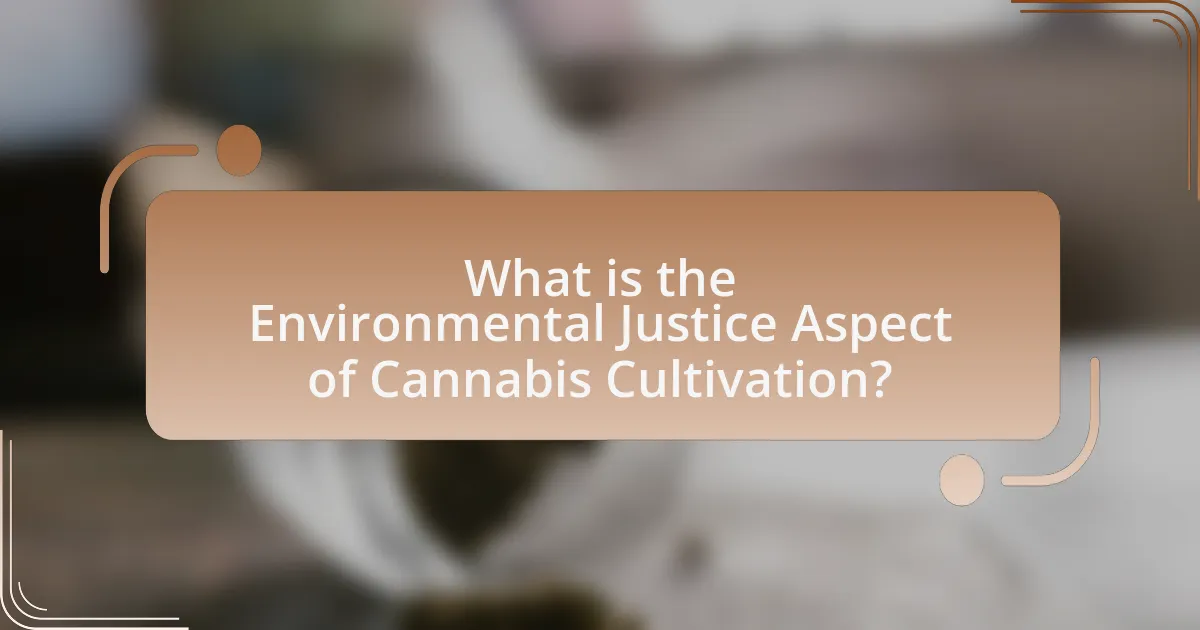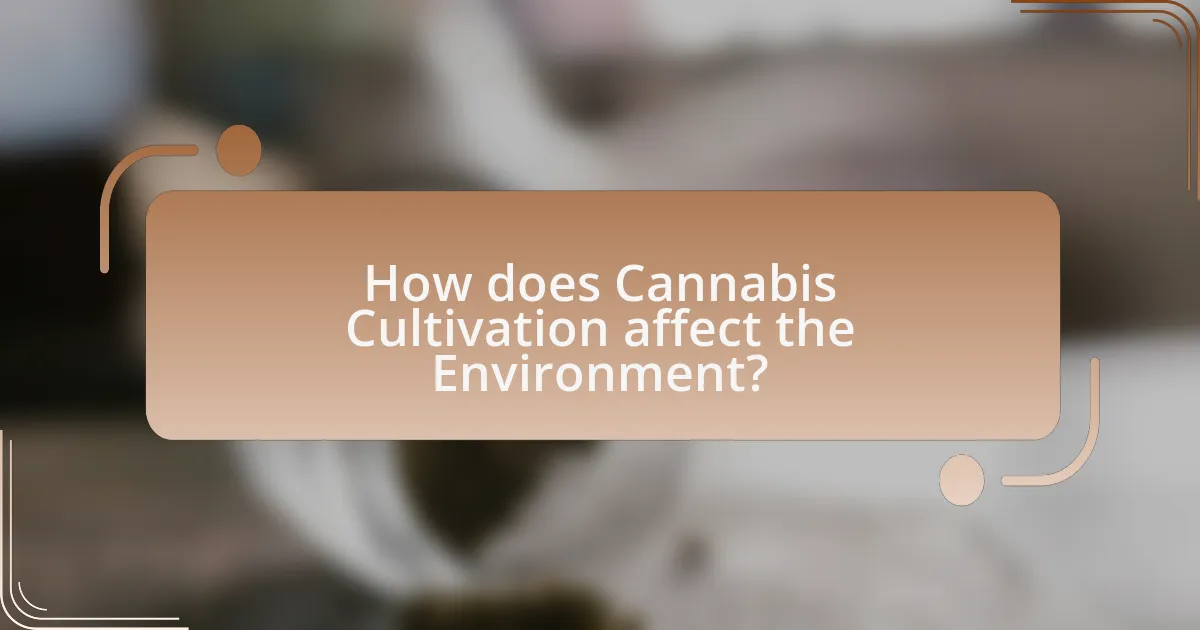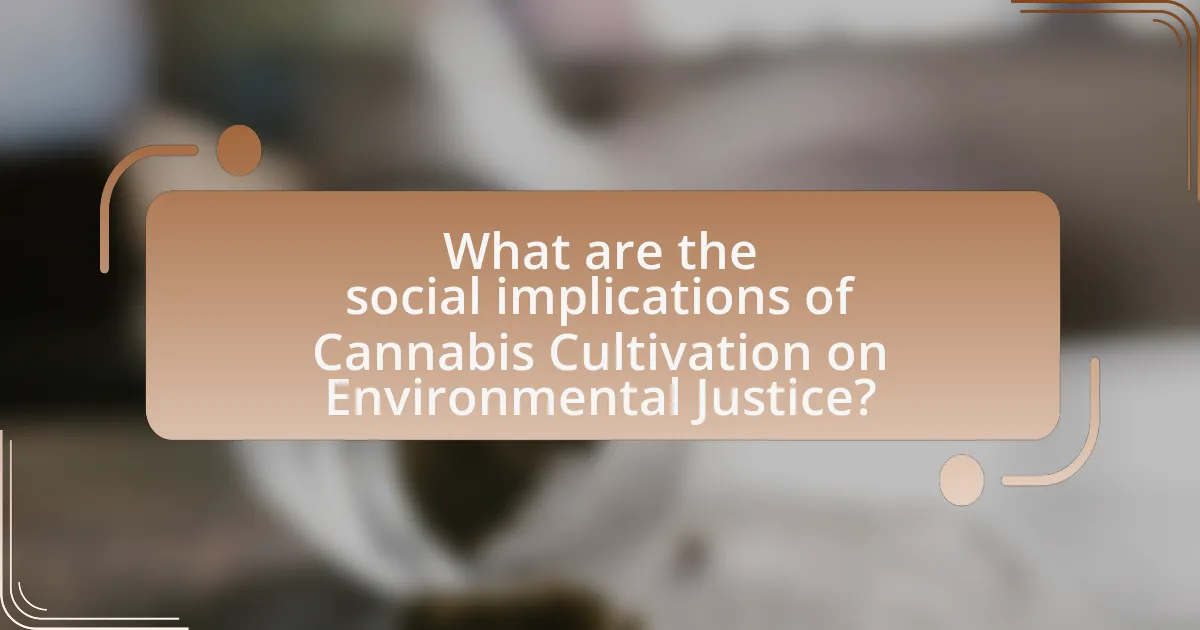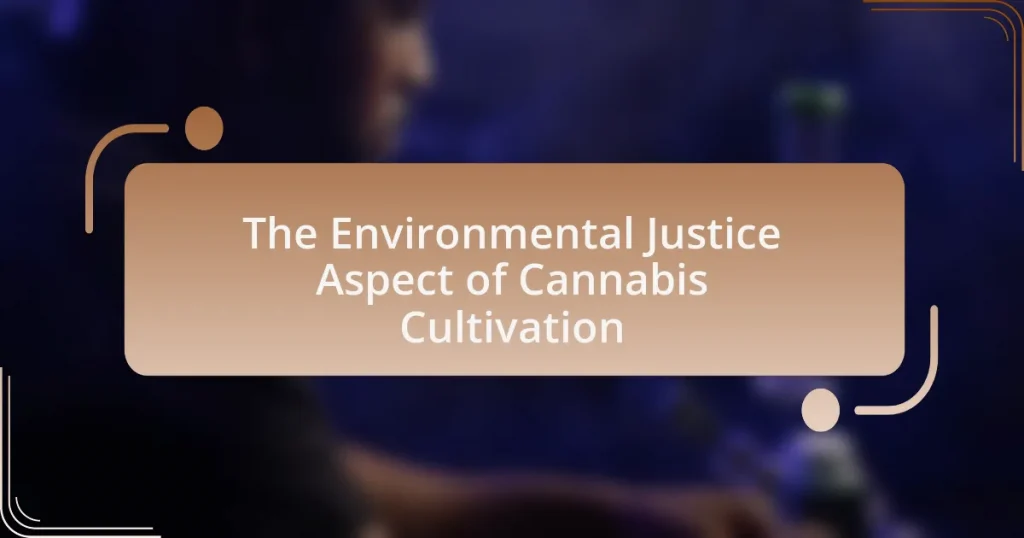The article examines the environmental justice aspect of cannabis cultivation, focusing on the equitable distribution of environmental benefits and burdens, particularly for marginalized communities disproportionately affected by pollution and land degradation. It highlights the historical injustices related to cannabis laws, the impact of cultivation practices on vulnerable populations, and the importance of sustainable farming methods. Key principles of environmental justice are discussed, emphasizing fair treatment and community involvement in decision-making processes. The article also addresses the social implications of cannabis legalization, the barriers faced by marginalized groups in the industry, and best practices for promoting equity and sustainability in cannabis cultivation.

What is the Environmental Justice Aspect of Cannabis Cultivation?
The environmental justice aspect of cannabis cultivation addresses the equitable distribution of environmental benefits and burdens associated with cannabis farming. This includes ensuring that marginalized communities, often disproportionately affected by pollution and land degradation, have access to clean environments and are not subjected to the negative impacts of cannabis cultivation, such as water depletion and pesticide use. Research indicates that communities of color and low-income neighborhoods frequently face higher exposure to environmental hazards, making it crucial to implement sustainable practices in cannabis farming that prioritize social equity and environmental health. For instance, the legalization of cannabis in various states has prompted discussions about how to create regulations that protect vulnerable populations while promoting sustainable agricultural practices.
Why is Environmental Justice important in the context of Cannabis Cultivation?
Environmental Justice is crucial in the context of Cannabis Cultivation because it addresses the disproportionate environmental impacts on marginalized communities. These communities often face higher exposure to pollution and land degradation due to industrial practices, including those associated with cannabis farming. For instance, studies have shown that cannabis cultivation can lead to water depletion and pesticide runoff, which disproportionately affect low-income neighborhoods and communities of color. Ensuring Environmental Justice in cannabis cultivation promotes equitable access to clean environments and mitigates the adverse effects of cultivation practices on vulnerable populations.
What are the historical injustices related to cannabis cultivation?
Historical injustices related to cannabis cultivation include the disproportionate targeting and criminalization of marginalized communities, particularly Black and Latino populations, during the War on Drugs initiated in the 1970s. This campaign led to severe legal penalties for cannabis possession and cultivation, resulting in mass incarceration and long-lasting socio-economic impacts on these communities. For instance, despite similar usage rates, Black individuals were nearly four times more likely to be arrested for cannabis-related offenses compared to white individuals, as reported by the American Civil Liberties Union in their 2013 study. Additionally, the historical association of cannabis with racial stereotypes contributed to systemic discrimination and hindered access to economic opportunities in the cannabis industry for those previously criminalized.
How does cannabis cultivation impact marginalized communities?
Cannabis cultivation can significantly impact marginalized communities by providing economic opportunities and exacerbating social inequalities. In regions where cannabis is legalized, marginalized groups often gain access to jobs and entrepreneurship in the cannabis industry, which can lead to increased income and community investment. However, these benefits are frequently overshadowed by systemic barriers, such as limited access to capital, discriminatory practices in licensing, and ongoing stigmatization of cannabis use. For instance, a report by the Brookings Institution highlights that Black and Latino entrepreneurs face substantial hurdles in entering the legal cannabis market, despite higher rates of cannabis-related arrests in these communities prior to legalization. This duality illustrates that while cannabis cultivation has the potential to empower marginalized communities economically, it also risks perpetuating existing inequalities if equitable policies are not implemented.
What are the key principles of Environmental Justice?
The key principles of Environmental Justice include the fair treatment and meaningful involvement of all people, regardless of race, color, national origin, or income, in environmental decision-making processes. This principle emphasizes that no group should bear a disproportionate share of negative environmental consequences resulting from industrial, governmental, and commercial operations. Additionally, Environmental Justice advocates for the right to a healthy environment, equitable access to resources, and the protection of vulnerable communities from environmental hazards. These principles are supported by the 1994 Executive Order 12898, which aimed to address environmental justice in minority and low-income populations, highlighting the need for inclusive policies that ensure environmental benefits and burdens are shared equitably.
How do these principles apply to cannabis cultivation?
The principles of environmental justice apply to cannabis cultivation by ensuring equitable access to resources, protection from environmental harms, and participation in decision-making processes for all communities, particularly marginalized ones. These principles advocate for sustainable practices that minimize ecological impact, such as organic farming methods and water conservation techniques, which are essential in cannabis cultivation. For instance, studies show that sustainable cannabis farming can reduce pesticide use by up to 90%, thereby protecting local ecosystems and public health. Additionally, involving local communities in the cultivation process fosters economic opportunities and empowers individuals, aligning with the core tenets of environmental justice.
What role does community involvement play in promoting Environmental Justice?
Community involvement is crucial in promoting Environmental Justice as it empowers marginalized groups to advocate for their rights and influence decision-making processes. Engaging local communities allows for the identification of specific environmental issues they face, such as pollution or lack of access to clean resources. For instance, studies show that communities actively participating in environmental assessments can lead to more equitable policies and practices, as seen in the case of the Environmental Protection Agency’s Community Action for a Renewed Environment program, which emphasizes local input in environmental decision-making. This involvement not only raises awareness but also fosters collaboration between community members and policymakers, ensuring that the voices of those most affected by environmental injustices are heard and addressed.

How does Cannabis Cultivation affect the Environment?
Cannabis cultivation significantly affects the environment through resource consumption and ecological impact. The process requires substantial water usage, with some estimates indicating that outdoor cannabis farms can consume up to 6 gallons of water per plant per day, leading to water scarcity in regions already facing drought. Additionally, the use of fertilizers and pesticides in cannabis farming can result in soil degradation and water pollution, as runoff can contaminate local waterways. Furthermore, illegal cultivation often leads to deforestation and habitat destruction, as growers clear land to establish farms, disrupting local ecosystems. These environmental consequences highlight the need for sustainable practices in cannabis cultivation to mitigate its ecological footprint.
What are the environmental impacts of cannabis cultivation?
Cannabis cultivation has significant environmental impacts, primarily including deforestation, water consumption, and pesticide use. Deforestation occurs as land is cleared for cultivation, disrupting local ecosystems and biodiversity. Water consumption is notably high; for instance, a single cannabis plant can require up to six gallons of water per day, leading to depletion of local water resources. Additionally, the use of pesticides and fertilizers can result in soil and water contamination, harming surrounding wildlife and plant life. These factors collectively contribute to environmental degradation associated with cannabis farming.
How does water usage in cannabis cultivation affect local ecosystems?
Water usage in cannabis cultivation significantly impacts local ecosystems by depleting water resources and altering natural habitats. High water consumption can lead to reduced stream flows and lower groundwater levels, which negatively affects aquatic life and surrounding vegetation. For instance, a study by the California Department of Fish and Wildlife found that illegal cannabis cultivation in the state often diverted water from streams, harming fish populations such as salmon and steelhead trout. Additionally, excessive water extraction can lead to soil degradation and increased salinity, further disrupting local flora and fauna. These ecological changes highlight the need for sustainable water management practices in cannabis farming to mitigate adverse effects on local ecosystems.
What are the effects of pesticide use in cannabis farming?
Pesticide use in cannabis farming can lead to significant negative effects on both human health and the environment. The application of pesticides may result in chemical residues on the cannabis plants, which can pose health risks to consumers, including potential carcinogenic effects and endocrine disruption. Additionally, pesticides can contaminate soil and water sources, harming local ecosystems and biodiversity. Studies have shown that certain pesticides, such as neonicotinoids, can adversely affect pollinators and other beneficial insects, which are crucial for maintaining ecological balance. Furthermore, the runoff from pesticide-treated areas can lead to water pollution, impacting aquatic life and drinking water quality.
What sustainable practices can be adopted in Cannabis Cultivation?
Sustainable practices in cannabis cultivation include organic farming, water conservation, and integrated pest management. Organic farming eliminates synthetic fertilizers and pesticides, promoting soil health and biodiversity. Water conservation techniques, such as drip irrigation and rainwater harvesting, reduce water usage and minimize runoff. Integrated pest management employs biological controls and natural predators to manage pests, reducing chemical inputs. These practices not only enhance environmental sustainability but also align with the principles of environmental justice by promoting healthier ecosystems and communities.
How can organic farming methods contribute to Environmental Justice?
Organic farming methods contribute to Environmental Justice by promoting sustainable agricultural practices that minimize harm to marginalized communities. These methods reduce the use of harmful pesticides and fertilizers, which disproportionately affect low-income and minority populations living near conventional farms. Research indicates that organic farming can improve soil health and biodiversity, leading to cleaner water and air quality, which benefits all community members. Additionally, organic farming often emphasizes local food systems, providing economic opportunities and access to healthy food in underserved areas, thereby addressing food deserts and enhancing community resilience.
What technologies can reduce the environmental footprint of cannabis cultivation?
Technologies that can reduce the environmental footprint of cannabis cultivation include advanced lighting systems, hydroponics, and renewable energy sources. Advanced lighting systems, such as LED grow lights, consume less energy and produce less heat compared to traditional lighting, resulting in lower electricity usage and reduced cooling needs. Hydroponics allows for water-efficient cultivation by using nutrient-rich water solutions instead of soil, significantly decreasing water consumption and runoff. Additionally, integrating renewable energy sources, like solar panels, can further minimize reliance on fossil fuels, thereby reducing greenhouse gas emissions associated with cannabis production. These technologies collectively contribute to a more sustainable cultivation process, aligning with environmental justice goals by promoting responsible resource use.

What are the social implications of Cannabis Cultivation on Environmental Justice?
Cannabis cultivation has significant social implications for environmental justice, particularly in terms of resource allocation and community impact. The legalization and commercialization of cannabis often lead to increased land use and water consumption, disproportionately affecting marginalized communities that may already face environmental burdens. For instance, studies indicate that large-scale cannabis farms can lead to water shortages in areas where water is already scarce, exacerbating existing inequalities. Furthermore, the regulatory frameworks surrounding cannabis cultivation frequently favor affluent growers, sidelining small-scale farmers and communities of color, which can perpetuate systemic injustices. This dynamic highlights the need for equitable policies that ensure fair access to resources and protect vulnerable populations from the adverse effects of cannabis cultivation.
How does cannabis legalization impact social equity?
Cannabis legalization positively impacts social equity by providing opportunities for marginalized communities that have historically faced criminalization due to cannabis laws. Legalization often includes provisions for expunging past cannabis-related convictions, which can alleviate barriers to employment and housing for affected individuals. For instance, states like California have implemented programs that prioritize social equity applicants for cannabis business licenses, aiming to rectify the disproportionate impact of previous cannabis prohibition on communities of color. According to a report by the Drug Policy Alliance, states that have legalized cannabis can create economic opportunities and generate tax revenue that can be reinvested in these communities, further promoting social equity.
What measures can be taken to ensure equitable access to cannabis cultivation opportunities?
To ensure equitable access to cannabis cultivation opportunities, regulatory frameworks must be established that prioritize inclusivity and support marginalized communities. These frameworks can include provisions for financial assistance, such as grants or low-interest loans, specifically aimed at individuals from historically disadvantaged backgrounds. Additionally, implementing training programs that educate potential cultivators on best practices and compliance can empower these communities. Evidence from states like California shows that social equity programs, which allocate licenses to individuals from communities disproportionately affected by cannabis prohibition, have increased participation among underrepresented groups in the cannabis industry. Furthermore, creating partnerships with local organizations can facilitate access to resources and networks, enhancing opportunities for equitable participation in cannabis cultivation.
How can policy changes promote Environmental Justice in the cannabis industry?
Policy changes can promote Environmental Justice in the cannabis industry by implementing regulations that ensure equitable access to resources and opportunities for marginalized communities. For instance, policies that prioritize licenses for minority-owned businesses can help rectify historical injustices faced by these groups in the cannabis sector. Additionally, regulations that mandate sustainable farming practices can reduce environmental harm in communities disproportionately affected by pollution and land degradation. Evidence from states like California shows that inclusive policies can lead to increased economic benefits for underrepresented populations, thereby fostering a more equitable industry.
What are the challenges faced in achieving Environmental Justice in Cannabis Cultivation?
Achieving Environmental Justice in Cannabis Cultivation faces several challenges, including regulatory disparities, environmental degradation, and social inequities. Regulatory disparities arise from inconsistent laws across jurisdictions, which can lead to unequal access to resources and opportunities for marginalized communities. Environmental degradation is often a result of large-scale cultivation practices that can harm local ecosystems, disproportionately affecting low-income neighborhoods. Social inequities manifest in the form of limited participation of underrepresented groups in the cannabis industry, which can perpetuate historical injustices. These challenges hinder the equitable distribution of environmental benefits and protections, making it difficult to achieve true Environmental Justice in this sector.
What barriers exist for marginalized communities in the cannabis industry?
Marginalized communities face significant barriers in the cannabis industry, primarily due to systemic inequities, financial constraints, and regulatory challenges. These communities often lack access to capital, which is crucial for starting and sustaining cannabis businesses; a report from the Minority Cannabis Business Association indicates that only 1% of cannabis businesses are owned by Black individuals, highlighting the financial disparity. Additionally, the complex regulatory landscape disproportionately affects marginalized groups, as they may not have the resources or knowledge to navigate licensing processes effectively. Historical injustices, such as the War on Drugs, have also led to a lack of trust in the industry and limited opportunities for participation.
How can advocacy groups address these challenges?
Advocacy groups can address the challenges of environmental justice in cannabis cultivation by promoting equitable policies and practices that ensure fair access to resources and decision-making processes for marginalized communities. These groups can engage in community organizing to raise awareness about the environmental impacts of cannabis cultivation, advocate for sustainable farming practices, and push for legislation that protects vulnerable populations from environmental harm. For instance, studies have shown that communities of color are disproportionately affected by environmental degradation; thus, advocacy groups can leverage this data to influence policy changes that prioritize environmental health and justice. By collaborating with local stakeholders and utilizing evidence-based research, advocacy groups can effectively address these challenges and foster a more equitable cannabis industry.
What best practices can be implemented for equitable Cannabis Cultivation?
Best practices for equitable cannabis cultivation include implementing community engagement, ensuring access to resources, and promoting diversity in ownership. Community engagement fosters collaboration with local stakeholders, ensuring that cultivation practices reflect the needs and values of the community. Access to resources, such as funding and training, is crucial for marginalized groups to participate in the industry, as evidenced by studies showing that equitable access can increase economic opportunities. Promoting diversity in ownership helps to dismantle historical inequities in the cannabis industry, as data indicates that diverse ownership leads to more inclusive business practices and community benefits.
How can community-led initiatives enhance Environmental Justice in cannabis cultivation?
Community-led initiatives can enhance Environmental Justice in cannabis cultivation by empowering local stakeholders to influence sustainable practices and equitable resource distribution. These initiatives often prioritize the needs and voices of marginalized communities, ensuring that they have a say in the environmental impacts of cannabis farming. For instance, community organizations can advocate for regulations that protect local ecosystems and promote organic farming methods, reducing harmful pesticide use. Research indicates that when communities are involved in decision-making, there is a higher likelihood of implementing practices that address both environmental sustainability and social equity, as seen in various case studies across states that have legalized cannabis.
What role do educational programs play in promoting sustainable practices?
Educational programs play a crucial role in promoting sustainable practices by equipping individuals with knowledge and skills necessary for environmentally responsible decision-making. These programs raise awareness about the environmental impacts of various practices, including cannabis cultivation, and encourage the adoption of sustainable methods such as organic farming, water conservation, and energy efficiency. Research indicates that educational initiatives can lead to significant behavioral changes; for instance, a study published in the Journal of Environmental Education found that participants in sustainability education programs were 30% more likely to implement eco-friendly practices in their daily lives. This demonstrates that targeted educational efforts can effectively foster a culture of sustainability within communities involved in cannabis cultivation and beyond.


